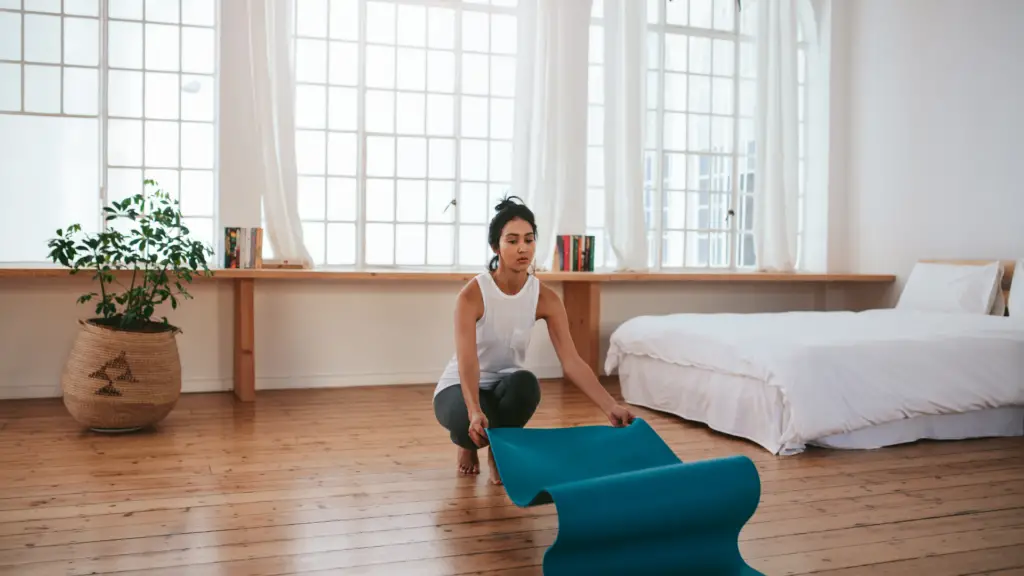Yogi approved by Keira Shepherd, Certified Yoga Instructor with a 1st Class Honors in Education Studies.
with a 1st Class Honors in Education Studies.
Yoga can help us to strengthen the muscles that are responsible for bladder control and urinary continence. With urinary incontinence being a condition that affects 300 million people worldwide, it’s time to start looking at straightforward and natural remedies to help those of us suffering from it.
When coupled with an engagement of the pelvic floor muscles, many yoga positions can strengthen the pelvic floor. Yoga poses can also make it easier for us to locate the pelvic floor and how to engage it.
The use of basic yoga poses coupled with props, can do wonders for strengthening our pelvic floor muscles. It also empowers us to gain control of urinary leaks and the embarrassment and difficulties that come with it.
Research into yoga and urinary incontinence found that women who took part in a 6-week yoga therapy program saw a 70% reduction in incontinence. Now that is something to celebrate. The group of women who did not participate in the yoga program only had a 13% improvement – so how can we effectively use yoga for urinary incontinence?
In this article, we will discuss everything you need to know about the pelvic floor – where it is, how to engage it, and how and which yoga exercises can help with urinary incontinence.
Medical Disclaimer: The information and recommendations on our site do not constitute a medical consultation. See a certified medical professional for diagnosis.
What is the pelvic floor?
The pelvic floor is a set of muscles running from the front of the pubic bone to the base of the spine – almost like a bowl. It keeps all of our pelvic organs in place and controls when we urinate, but also affects our posture, core strength, and sexual sensitivity.
Most of us come to learn about the pelvic floor during pregnancy, where the extra weight of carrying a baby around as well as childbirth can weaken our pelvic floor muscles and cause urinary incontinence. During and after pregnancy is when it’s considered particularly important to pay attention to and care for our pelvic floor.
What causes urinary incontinence?
Urinary incontinence can be caused by various factors – childbirth, aging, heavy lifting, being overweight, and surgery being the most common factors. It usually happens when the perineum has been overstretched or weakened and is, therefore, less effective in controlling our bladder and stopping us from urinating.
As the perineum helps with the passage and control of urine, it’s essential to keep it secure and healthy to avoid small accidents that can be common when we exercise, laugh, or just really need to use the bathroom!
How can yoga prevent urinary incontinence? 🧘
Is there anything that yoga can’t do?!
When we do pelvic floor exercises, we are strengthening the perineum. During yoga, you may have heard your teacher ask you to apply ‘Mula Bandha’ – whether or not you understood it at the time, this was their way of asking you to engage your pelvic floor muscles.
We will explain a little bit about Mula Bandha next
Mula Bandha 🧘
When turning to yoga for urinary incontinence, we have to start with Mula Bandha. Without it, many of the ‘effective’ poses will be nowhere near as effective in bringing to attention or strengthening the pelvic floor.
Engaging the pelvic floor, or practicing Mula Bandha can take a little practice – it’s a bit of an odd feeling that can feel weirdly uncomfortable at first. The good news is that it’s straightforward to practice, and with practice, you’ll find that it becomes easier and that you start to strengthen your pelvic floor.
The word Mula means root, while Bandha means a lock. In simpler terms, it means that we are applying a lock to the root chakra (the Muladhara), which is located between the perineum and the coccyx.
By applying Mula Bandha, we are strengthening the pelvic floor as well as locking in energy. Securing in this energy can bring a sense of calm and relaxation – it teaches us to seek our peace from within as opposed to always looking outside for the answers.
How to do it
Think of it as the same contraction that you need to make to stop urinating mid-flow. It’s the squeezing that you make in the perineum. Though it sounds straightforward, it can be a little awkward at first because many of us contract the respiratory muscles at the same time and don’t find it easy to isolate this tension. But with regular practice, it will be easy to isolate the pelvic floor muscles in this practice, and you’ll soon be reaping the benefits!
The benefits of Mula Bandha
The benefits of Mula Bandha go beyond the pelvic floor, with regular practice you can expect:
go beyond the pelvic floor, with regular practice you can expect:
- Lower respiration rate
- Reduction in blood pressure
- Improved digestion
- Regulation of the menstrual cycle
- Relief of chronic pain in the genitals
- Stronger core
It’s important to remember that the benefits also lie in the release of Mula Bandha – in other words, don’t spend all day keeping your pelvic floor locked! There are disadvantages to this – you could weaken the pelvic floor muscles by overworking them and making them tired. To strengthen, we also need to spend time softening. Muscles that are tight losing strength due to always being contracted and the same can happen with the pelvic floor.
by overworking them and making them tired. To strengthen, we also need to spend time softening. Muscles that are tight losing strength due to always being contracted and the same can happen with the pelvic floor.
Yoga poses for urinary incontinence 🧘

Once you’ve practiced engaging your pelvic floor muscles, you can start practicing yoga alongside Mula Bandha. Here are some of the best yoga poses for urinary incontinence.
Tadasana
Sometimes the best way to practice is to keep things simple! Standing tall with your feet hip-width apart, try squeezing the pelvic floor muscles to connect to them. After, you can place a block between the thighs and imagine that you are trying to pull it up towards your abdomen.
Chair Pose
Start from a standing position with your legs hip-width apart, and then draw your buttocks back as though sitting down into a chair. Stop before your hips go lower than your knees, then engage the pelvic floor with Mula Bandha, hold for 5 seconds, then release as you come back to standing. Repeat this three times.
Yogi squat
Start from a standing position with the feet as wide as the shoulders. Bring your hands to a prayer position, and then sink the hips into a deep squat turning the toes slightly out towards the sides as you do so. Use a block underneath the glutes to keep your feet firmly planted on the ground if necessary. Push the elbows into the knees to allow you to grow tall through the spine, which will open up your pelvic floor for better engagement and softening.
Warrior II
Start from a standing position with your feet hip-width distance. Step backward with the right foot, and turn the right toes out to 90 degrees, pointing towards the edge of your mat. Keep a deep bend in the left knee as you gaze over the left fingertips, keeping your torso turned towards the right. You can engage the pelvic floor by making very small tucking and untucking movements with the pelvis. Repeat on the other side.
Reclined Butterfly Pose
This pose is excellent for focusing on the pelvic floor while physically relaxing the rest of the body. Lay all the way down onto the mat, and bring the soles of your feet to touch. Rest the arms to the sides, the belly, or overhead, then engage your pelvic floor muscles. Hold for up to 15 seconds, release for 5-10, then repeat. If you find that this pose is particularly painful in the groin or hips, bring a cushion or block underneath both knees to bring them slightly away from the ground.
Bridge Pose
Laying on your back, bend your knees to bring the heels about one palm-print away from the glute muscles. From here, place a block between your thighs and push into the feet as you lift the hips up and away from the floor towards the sky. The presence of the block will help you to turn the hips to relax the glutes and to engage the pelvic floor.
Avoid those sneaky leaks!

Don’t suffer through urinary incontinence, and give a few of these poses a try alongside your newly learned skill of applying Mula Bandha. Practicing yoga is a great way to strengthen the mind, spirit, and body – so while you’re holding those pelvic floor muscles tight, remember all of the good that it’s doing for the rest of your body and wellbeing.
– so while you’re holding those pelvic floor muscles tight, remember all of the good that it’s doing for the rest of your body and wellbeing.
How Yoga And Meditation Change Your Personality 🧘

Keira Shepherd is a certified yoga teacher living in Toulouse, France. Originally from the UK, Keira received a First-Class Honours degree in Education Studies at Oxford Brookes University after completing her dissertation on the topic of using special technologies when teaching children with autism. Keira is a keen traveler and has spent a lot of time teaching a variety of different practices – such as yoga and scuba diving – around the world. Now settled in France, she is a mother of one and shares her passion for an environmentally sustainable life through her motherhood blog .
.
References
- https://www.tena.us/incontinence-information/yoga-intro,en_US,pg.html

- https://www.healthline.com/health/kegel-exercises#cautions

